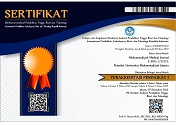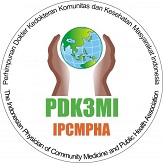Protective Effect of Combination Commercial Black Seed Oil (Nigella sativa) and Honey Against Cisplatin-Induced Hepatotoxicity in Rats
Abstract
Keywords
Full Text:
PDFReferences
Gold JM RA. Cisplatin (Cisplatinum). Treasure Island (FL): StatPearls; 2019.
Bano N, Najam R. Histopathological and biochemical assessment of liver damage in albino Wistar rats treated with cytotoxic platinum compounds in combination with 5-fluorouracil. Arch Med Sci. 2019;15(4):1092–103.
Poluektova LY, Arnold LL, Kabanov A V, Cohen SM, Bronich TK. Cisplatin-loaded core cross-linked micelles : comparative pharmacokinetics, antitumor activity, and toxicity in mice. Intern J Nanomed. 2012;7:2557–71.
Desai SD, Saheb SH, Das KK, Haseena S. Effect of Thymoquinone on MDA and SOD levels in Sterptozotocine Induced Diabetic Albino Rats . J Pharm Sci Res. 2015;7(8):523–6.
Ayala A, Muñoz MF, Argüelles S. Lipid peroxidation: Production, metabolism, and signaling mechanisms of malondialdehyde and 4-hydroxy-2-nonenal. Oxid Med Cell Longev. 2014;2014:1–31.
Forouzanfar F, Fazly Bazzaz BS, Hosseinzadeh H. Black cumin (Nigella sativa) and its constituent (thymoquinone): A review on antimicrobial effects. Iran J Basic Med Sci. 2014;17(12):929–38.
Miguel MG, Antunes MD, Faleiro ML. Honey as a complementary medicine. Integr Med Insights. 2017;12:1–15.
Abdallah MA, Zayed MA, Kelany ME. Antioxidant and antiapoptic effects of combined sidr honey and nigella sativa oil against paracetamol-induced hepato- nephrotoxicity in rats. ZUMJ. 2016;22(1):1–12.
Alkadri SLF, Ilmiawan MI, Handini M. Efek Protektif Kombinasi Minyak Jintan Hitam dan Madu terhadap Hepatotoksisitas pada Tikus Akibat Sisplatin (The Protective Effects of The Combination of Black Cumin Oil and Honey against Hepatotoxicity in Rats Due Sisplatin). eJKI. 2019;7(2):101–8.
Wills ED. Mechanisms of Lipid Peroxide Formation in Animal Tissues. Biochem J. 1966;99:667–76.
Chou TC. Drug combination studies and their synergy quantification using the chou-talalay method. Cancer Res. 2010;70(2):440–6.
Ansarin K, Khoubnasabjafari M, Jouyban A. Reliability of malondialdehyde as a biomarker of oxidative stress in psychological disorders. BioImpacts. 2015;5(3):123–7.
Palipoch S, Punsawad C, Koomhin P, Suwannalert P. Hepatoprotective effect of curcumin and alpha-tocopherol against cisplatin-induced oxidative stress. BMC Complement Altern Med. 2014;14(1):1–8.
Üstün R, Kaval E, Korkaya H. Thymoquinone prevents cisplatin neurotoxicity in primary DRG neurons. 2018;69:68–76.
Mahmoud YK, Abdelrazek HMA. Biomedicine & Pharmacotherapy Cancer : Thymoquinone antioxidant / pro-oxidant e ff ect as potential anticancer remedy. 2019;115(2019):1–14.
Sheikhbahaei F, Khazaei M, Rabzia A, Mansouri K, Ghanbari A. Protective Effects of Thymoquinone against Methotrexate-Induced Germ Cell Apoptosis in Male Mice. Int J Fertil Steril. 2016;9(4):541–7.
Farooqui Z, Ahmed F, Rizwan S, Shahid F, Khan A, Khan F. Protective effect of Nigella sativa oil on cisplatin induced nephrotoxicity and oxidative damage in rat kidney. Biomed Pharmacother. 2017;85:7–15.
Neamatallah TA, Nagla AE, Aymn TA, Soad SA BG. Honey protects against cisplatin-induced hepatic and renal toxicity through inhibition of NF-kB-mediated COX-2 expression and oxidative stress dependent BAX/Bcl-2/caspase-3 apoptotic pathway. Food Funct. 2018;1–33.
Bela Risqiyani Fajrilah. Pengaruh Pemberian Madu Terhadap Kadar Malondialdehyde (MDA) Plasma Darah pada Tikus Putih Galur Wistar yang Diinduksi Alloxan (The Effect of Honey on The Levels of Malondialdehyde (MDA) Blood Plasma in White Rats Strain Wistar Induced Alloxan). Sains Med. 2013;5(2):98–100.
Al-Farsi M, Al-Amri A, Al-Hadhrami A, Al-Belushi S. Color, flavonoids, phenolics and antioxidant of Omani honey. Heliyon. 2018;4.
Cianciosi D, Hernandes TYF, Afrin S, Gasparrini M, Rodriguez PR, Manna PP, et al. Phenolic compounds in honey and their associated health benefits: A review. Molecules. 2018;23:1–20.
Mohamad S, Ibrahim N, Yusof H. Blood Pressure and Lipid Lowering Effects of Nigella sativa Seeds and Honey Mixture. IOSR J Nurs Heal Sci. 2014;3(5):89–96.
Gupta VK, Sharma SK. Plants as natural antioxidants. Nat Prod Radiance. 2006;5(4):326–34.
DOI: https://doi.org/10.24853/mmj.1.2.43-48
Refbacks
- There are currently no refbacks.
Indexed by:
Work is distributed under the Creative Commons Attribution-NonCommercial 4.0 International License.
Copyright of Muhammadiyah Medical Journal (e issn: 2721-317X)













13.jpg)
